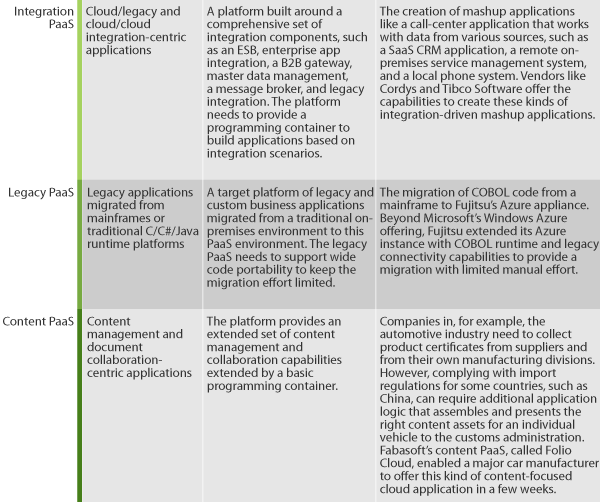Platform-As-A-Service: Cloud Providers’ Silver Bullet?
I’ve been writing about platform-as-a-service (PaaS) since the beginning of 2009, and we published our first Forrester Wave™ on the PaaS market about 18 months ago. While the lines between IaaS, PaaS, and SaaS are blurring in the minds of some end users and developers, delivering PaaS requires a lot more intellectual property on the part of the cloud provider. IaaS is “just” the offering of an industrialized infrastructure service — but full PaaS service turns the cloud provider basically into a real software vendor or VAR of a decent stack of software platform components.
The market has undergone amazing changes since 2009 and the market landscape has been shaken up considerably since the last Forrester Wave. Why? A number of vendors have joined the crowd from three different directions:
- IaaS cloud providers such as Amazon are moving up the stack to PaaS. From advanced database, messaging, and parallel processing to identity management and federation services, Amazon is arming itself with a myriad of value-added PaaS services to combat margin pressure in the commoditizing pure infrastructure space. Other IaaS providers are about to follow, most by OEMing PaaS stacks like those from Cordys or LongJump, or some other PaaS stack that is available to third-party infrastructure provider models.
- Middleware vendors such as Oracle and Tibco are getting more serious about the cloud, offering fully managed services of their stacks in the cloud. In an effort to maintain customers, developers, and revenue, some of these middleware vendors are rearchitecting their offerings to match the characteristics of the cloud.
- SaaS providers are unlocking the key to their code bases, allowing corporate app developers and external ISVs to configure solutions to their exact needs.
My upcoming Forrester webinar on December 6, 2012 will specifically show which options cloud providers have to move into the less commoditized PaaS zone by planning with PaaS capability segments.


Here’s a quick preview: Forrester identified six capability segments of PaaS capabilities in the recent report Multiple PaaS Flavors Hit The Enterprise. Each PaaS offering on the market today focuses on one or a combination of some of these capabilities (see the above figure):
- Foundational PaaS. This capability is somehow required in every PaaS offering. But foundational PaaS requires more than infrastructure components; developer efficiency needs to be accelerated by a high level of preintegration between all technology components and an add-on marketplace offering components prebuilt by third-party developers.
- Application PaaS. This could also be called “PaaS around an SaaS application.” Vendors who manage to separate a generalized platform stack from their major SaaS application such as salesforce.com are strong on this capability. PaaS becomes both the home for new business apps and the natural extension of their SaaS apps. Microsoft, with its Dynamics and Azure fragmentation, still has a very long way to go to realize this.
- Integration PaaS. Middleware vendors such as Cordys and Tibco are catalyzing the creation of mashed-up apps that link on-premises systems with the cloud via a comprehensive set of integration components such as B2B gateways, message brokers, and master data management.
- Legacy PaaS. This is an exciting capability to rehost legacy code (such as Cobol or old Java code) into the cloud but then complement it with additional new business logic in modern programming languages on a preintegrated stack.
- Process PaaS. This is a key capability for users who have embraced cloud-based collaboration suites such as Google Apps. Now they need to reimplement sophisticated workflow management of their legacy solutions, such as Lotus Notes, via a cloud-based set of business process modeling, execution, and simulation capabilities.
- Content PaaS. Fabasoft, with its Foliocloud.com, paved the road for this capability segment. It allows users to develop sophisticated application logic on top of a set of content management and collaboration capabilities. The synergy of structured and unstructured data as well as workflows accessible in a modern programming model are key.
My report Multiple PaaS Flavors Hit The Enterprise shows many vendors’ focuses across these six capability segments. This list includes Amazon, Appfog, Appian, Caspio, CloudBees, Cordys, CumuLogic, Engine Yard, Fabasoft, Fujitsu, Informatica, Jelastic, LongJump, Mendix, Microsoft, MuleSoft, NetSuite, Oracle, OrangeScape, Pegasystems, Pervasive, Red Hat, RunMyProcess, salesforce.com, SAP, Tibco Software, VMware, WorkXpress, and WSO2. If you’re currently a cloud IaaS provider you could host some of these technology stacks in your data center. Most of them offer at least interesting partner models. Join our webinar, Platform-As-A-Service: Cloud Providers’ Silver Bullet?, on Thursday, December 6, 2012 from 11 a.m. to 12 p.m. EST (16:00-17:00 GMT) to learn more.
Stefan Ried